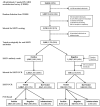Population-based assessment of kaposi sarcoma-associated herpesvirus DNA in plasma among Ugandans
- PMID: 23852686
- PMCID: PMC3755768
- DOI: 10.1002/jmv.23613
Population-based assessment of kaposi sarcoma-associated herpesvirus DNA in plasma among Ugandans
Abstract
Risk of Kaposi sarcoma (KS) is linked to detection of Kaposi sarcoma-associated herpesvirus (KSHV) DNA in plasma, but little is known about the prevalence and risk factors for plasma KSHV DNA detection among the general population where KS is endemic. Correlates of KSHV plasma detection were investigated in a population-based sample of adult Ugandans (15-59 years) who participated in an HIV/AIDS serobehavioral survey in 2004/2005. KSHV DNA was measured in plasma of 1,080 KSHV seropositive and 356 KSHV seronegative persons using polymerase chain reaction (PCR). KSHV DNA in plasma was detected in 157 (8.7%) persons; of these 149 (95%) were KSHV seropositive and 8 (5%) were seronegative. Detection of KSHV DNA in plasma was significantly associated with male sex (P < 0.001), older age (P = 0.003), residence in a rural versus urban area (P = 0.002), geographic region (P = 0.02), and being KSHV seropositive (13.8% seropositive vs. 2.3% seronegative, P < 0.001). In a multivariable model, KSHV DNA plasma quantity was significantly higher in men (P = 0.002), inversely associated with age (P = 0.05), and residing in an urban area (P = 0.01). In Uganda, KSHV is detected more frequently in the plasma of adult males and residents of rural regions, potentially explaining the increased risk of KS in these subsets of the Ugandan population.
Keywords: *Kaposi sarcoma; Kaposi sarcoma-associated herpesvirus; epidemiology; plasma; uganda.
Copyright © 2013 Wiley Periodicals, Inc.
References
-
- Kaposi's sarcoma and Pneumocystis pneumonia among homosexual men--New York City and California. MMWR Morb Mortal Wkly Rep. 1981;30:305–308. - PubMed
-
- Ariyoshi K, Schim van der Loeff M, Cook P, Whitby D, Corrah T, Jaffar S, Cham F, Sabally S, O'Donovan D, Weiss RA, Schulz TF, Whittle H. Kaposi's sarcoma in the Gambia, West Africa is less frequent in human immunodeficiency virus type 2 than in human immunodeficiency virus type 1 infection despite a high prevalence of human herpesvirus 8. Journal of human virology. 1998;1:193–199. - PubMed
-
- Biggar RJ, Whitby D, Marshall V, Linhares AC, Black F. Human herpesvirus 8 in Brazilian Amerindians: a hyperendemic population with a new subtype. The Journal of infectious diseases. 2000;181:1562–1568. - PubMed
-
- Biryahwaho B, Dollard SC, Pfeiffer RM, Shebl FM, Munuo S, Amin MM, Hladik W, Parsons R, Mbulaiteye SM. Sex and geographic patterns of human herpesvirus 8 infection in a nationally representative population-based sample in Uganda. The Journal of infectious diseases. 2010;202:1347–1353. - PMC - PubMed
-
- Bunnell R, Opio A, Musinguzi J, Kirungi W, Ekwaru P, Mishra V, Hladik W, Kafuko J, Madraa E, Mermin J. HIV transmission risk behavior among HIV-infected adults in Uganda: results of a nationally representative survey. AIDS (London, England) 2008;22:617–624. - PubMed
MeSH terms
Substances
Grants and funding
LinkOut - more resources
Full Text Sources
Other Literature Sources



